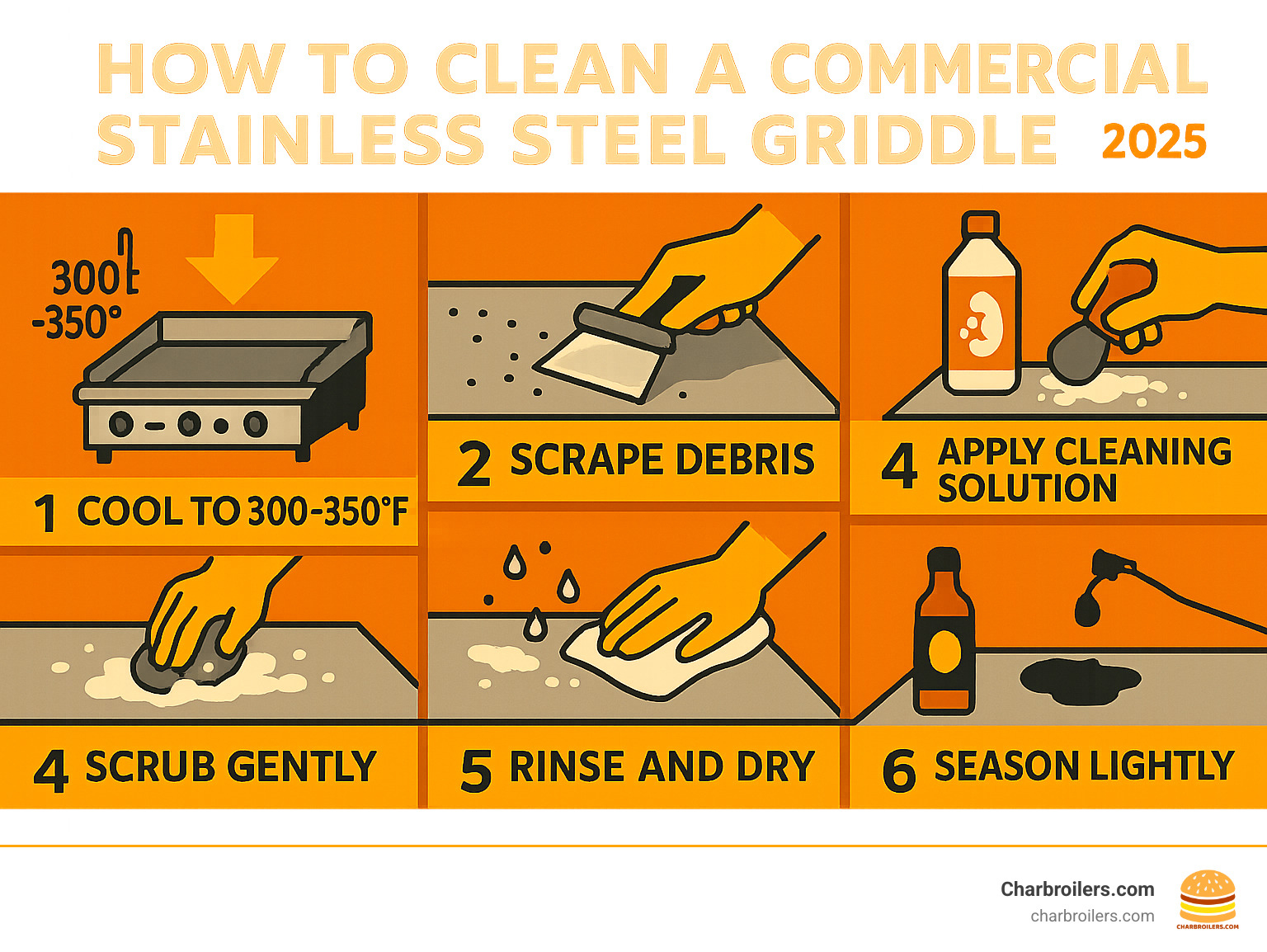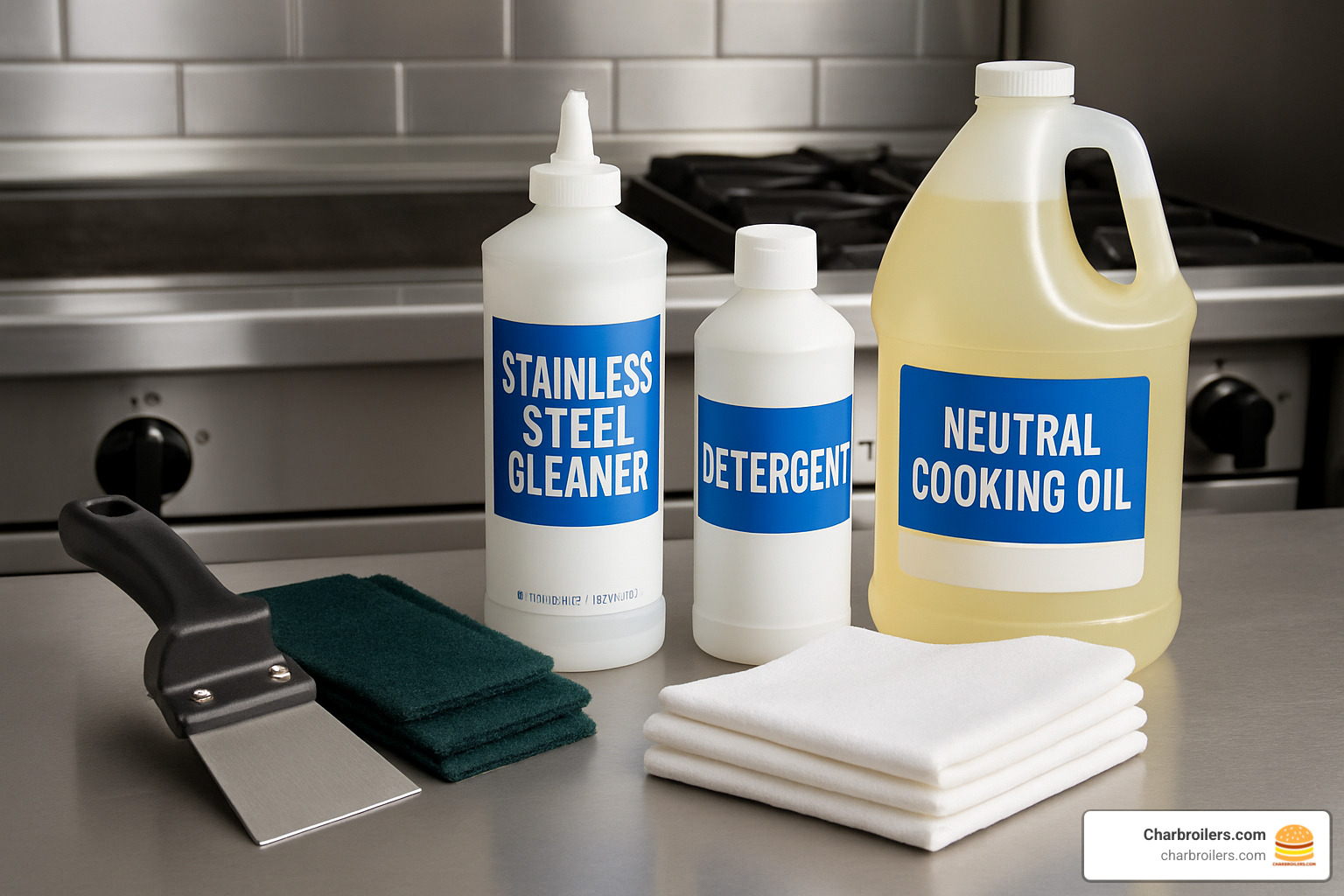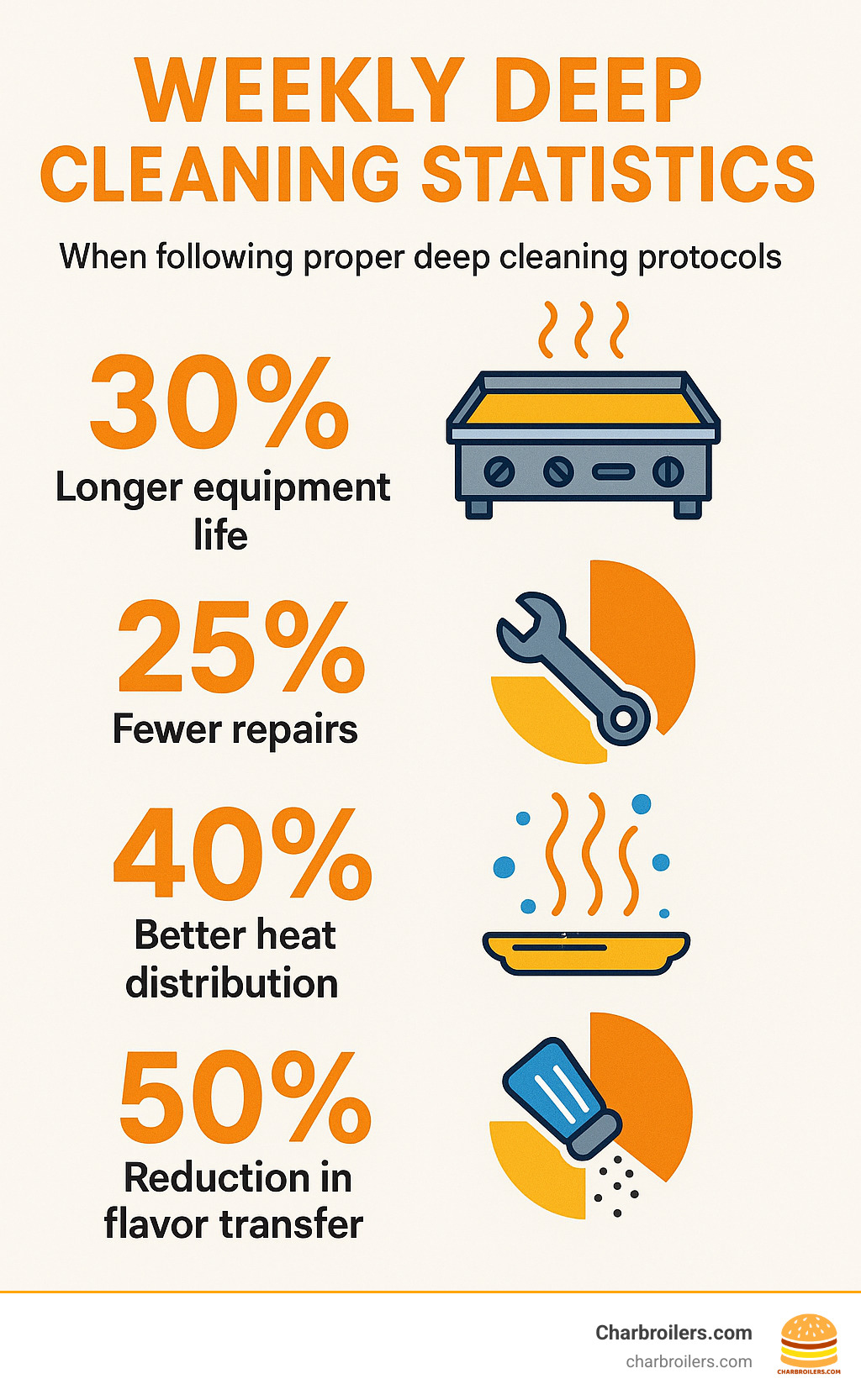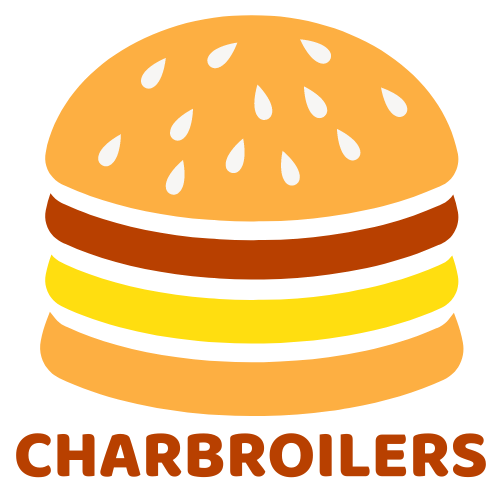
The Ultimate Guide to Cleaning a Commercial Stainless Steel Griddle
Share
Why Your Commercial Griddle's Cleanliness Determines Your Kitchen's Success
How to clean a commercial stainless steel griddle properly is crucial for any busy kitchen. Here's the quick answer:
- Cool to 300-350°F - Never use ice or cold water
- Scrape debris while warm using a griddle scraper
- Apply cleaning solution - Use stainless steel-safe detergent
- Scrub gently with non-abrasive pad in circular motions
- Rinse and dry with clean cloths
- Season lightly with cooking oil to prevent rust
Your griddle works harder than almost any other piece of kitchen equipment. It's often the last surface your food touches before reaching customers.
Poor griddle maintenance leads to serious problems: - Uneven heat transfer causing inconsistent cooking - Flavor contamination between dishes - Food safety risks from bacteria buildup - Equipment damage costing thousands in repairs - Fire hazards from grease accumulation
Regular cleaning delivers real ROI:
- Extended equipment lifespan
- Consistent food quality every shift
- Lower repair and replacement costs
- Safer working environment
I'm Sean Kearney from Charbroilers.com, and after over a decade in the restaurant equipment industry, I've seen how proper griddle maintenance separates successful kitchens from struggling ones. Learning how to clean a commercial stainless steel griddle correctly will transform your kitchen operations and protect your investment.

Why Regular Cleaning Matters
How to clean a commercial stainless steel griddle regularly isn't just about keeping things shiny—it's the difference between a thriving kitchen and a dangerous, money-losing operation.
Your Customers' Health Depends on It
Every time you skip proper cleaning, you're rolling the dice with food safety. Grease and food debris become breeding grounds for bacteria that can make customers seriously sick. One foodborne illness outbreak can shut down your restaurant and destroy your reputation.
Heat Transfer Gets Destroyed by Dirt
A dirty griddle creates an insulating layer between heating elements and the cooking surface, causing hot spots and cold spots. Research shows that a dirty griddle can reduce heat transfer efficiency by up to 30%—that's money literally burning away.
Flavor Contamination Ruins Everything
Without proper cleaning between dishes, flavors transfer and contaminate new orders. As one industry expert put it: "Heat will not transfer evenly and can cause dinnertime beef to taste like brunchtime chicken."
Your Equipment Investment Needs Protection
Commercial griddles cost thousands of dollars. Regular cleaning can add years to your griddle's lifespan, while neglect leads to expensive problems like corrosion, warping, and premature component failure.
Fire Hazards Are Real and Dangerous
Grease buildup can ignite without warning, causing flare-ups that put staff and customers at risk. Regular cleaning removes these combustible materials before they become dangerous. For detailed information on preventing grease-related hazards, check out this Scientific research on grease hazards.
Proper griddle maintenance isn't optional—it's essential for running a safe, profitable, and successful kitchen operation.
Gear & Cleaners: What to Use and Avoid
The right tools make how to clean a commercial stainless steel griddle so much easier. Let's talk about what belongs in your cleaning arsenal and what could damage your investment.
Your Essential Cleaning Toolkit
Your griddle scraper is your best friend. This flat-edged metal tool removes stuck-on food without scratching. Keep that edge flush against the griddle, and replace it when it gets dull.
Pad holder with non-abrasive pads gives you steady pressure while protecting both you and your griddle surface. Never scrub with bare hands—that's a recipe for burns.
Personal protection equipment (PPE) includes heat-resistant gloves, safety glasses, non-slip shoes, and an apron. Griddle cleaning can get messy and dangerous.
Cooking oil for seasoning after cleaning. Neutral oils like vegetable or canola work perfectly.
The Right Cleaning Agents Matter
Stainless steel detergent designed for commercial use is non-negotiable. Products like affresh® stainless cleaner work great because they're formulated specifically for food service equipment.
Water temperature is crucial. Room temperature or warm water works best when your griddle has cooled to 300-350°F.
The Never-Ever List
| Safe to Use | Never Use |
|---|---|
| Non-abrasive pads | Steel wool pads |
| Stainless steel cleaners | Bleach or chlorine |
| Room temperature water | Ice or ice water |
| Griddle scrapers | Sharp knives |
| Food-safe detergents | Household cleaners |
| Soft cloths | Abrasive towels |
Avoid ice or cold water at all costs. Thermal shock from rapid temperature changes causes stress cracks, warping, and permanent damage costing thousands.
Steel wool scratches the surface, creating grooves where bacteria can hide. Household cleaners aren't designed for food contact surfaces and can leave harmful residues.
For more insights into maintaining commercial kitchen equipment, check out our Guide to Commercial Charbroilers for Your Restaurant.

How to Clean a Commercial Stainless Steel Griddle
Let's walk through the actual process of how to clean a commercial stainless steel griddle step by step, covering daily cleanups to thorough weekly maintenance.
The Magic Temperature: 300-350°F
Your griddle needs to be at 300-350°F for optimal cleaning. Not too hot that you'll burn yourself, not too cold that grease hardens up. At this temperature, everything loosens up beautifully without shocking your equipment.
The Scrape-First Rule
Before reaching for cleaning solutions, grab your griddle scraper. This removes the bulk of debris while it's still manageable—like clearing the table before washing dishes.
The Squirt, Scour, Squeegee Method
Squirt your stainless steel-safe cleaning solution across the warm surface, letting it work for about 30 seconds. Then scour with your non-abrasive pad using light, circular motions. Finally, squeegee away all the loosened grime with smooth, overlapping strokes.
Daily Routine: Your Non-Negotiable Habit
Every shift should end with complete griddle cleaning. Skip it once, and you'll pay for it later. This daily ritual prevents buildup that turns a 10-minute job into an hour-long nightmare.
Between-Service Touch-Ups
Continuous maintenance beats marathon cleaning sessions. Quick scrapes between menu items, fast wipes of splashes, and regular grease tray emptying keeps your griddle in peak condition.
Weekly Deep Clean
Once a week, your griddle deserves the full treatment. This involves stubborn carbonized buildup removal to complete re-seasoning.
Thermal Shock: The Silent Equipment Killer
Never use ice or cold water to speed up cooling. Thermal shock can create stress cracks, warping, and expensive damage that no amount of cleaning can fix.
For more insights on maximizing your equipment investment, check out our 48-Inch Commercial Flat Top Grill Guide: Cooking Up Success.

Daily Cleaning: How to Clean a Commercial Stainless Steel Griddle in Under 10 Minutes
How to clean a commercial stainless steel griddle becomes second nature when you break it down into manageable chunks.
Getting Ready: The One-Minute Setup
Safety gear goes on first—heat-resistant gloves and safety glasses. Turn off the thermostat and let your griddle cool to 300-350°F. Gather all supplies within arm's reach.
The Great Scrape: Two Minutes
Keep your scraper flat against the surface and work systematically from one end to the other. Those two minutes of thorough scraping save serious elbow grease later.
Solution Time
Squirt stainless steel-safe cleaning solution across the warm surface. Let it sit for about 30 seconds while the chemistry does the heavy lifting.
The Scrubbing Dance: Three Minutes
Work in small, overlapping circles with light pressure using your non-abrasive pad. The cleaning solution has already loosened everything up.
Rinse and Shine: Two Minutes
First pass with a damp cloth removes all loosened grime and cleaning solution. Follow immediately with a dry, lint-free cloth for a bone-dry surface.
The Final Touch: One Minute
A thin layer of cooking oil spread evenly across the surface is your griddle's insurance policy against rust and sticking.
Between-Service Touch-Ups
The real secret isn't just knowing how to clean a commercial stainless steel griddle at day's end—it's maintaining it throughout service.
The Continuous Scrape Strategy
Every time you finish cooking an item, give that surface a quick scrape. It takes seconds but prevents food particles from turning into carbonized cement.
Splash Zone Patrol
Grease loves to travel. A quick wipe of backsplash and side panels every half hour keeps everything manageable.
Grease Trough Management
Check the grease trough every hour—don't let it get anywhere near full. An overflowing trough is a legitimate fire hazard.
The Lightning-Fast Touch-Up
When you spot trouble during service, scrape the problem area while warm, hit it with cleaning solution, quick scrub, wipe clean, dry off, and add light oil. Two minutes keeps your griddle performing like new.
Deep Cleaning: Weekly Griddle Maintenance
Once a week, your hardworking griddle deserves the full spa treatment.
Setting the Stage
Schedule during your slowest period. Let the griddle cool completely below 200°F. Clear your workspace and gather everything you'll need.
The Detective Work
Inspect for stress cracks, warping, or rust. Note areas with heavy carbonization that need extra attention.
Griddle Brick: Your Secret Weapon
For stubborn, carbonized spots, a griddle brick (pumice stone designed for stainless steel) removes buildup that seems permanently welded. Use light pressure and circular motions.
The Soaking Strategy
Apply cleaning solution generously to problem areas and let it sit for 10-15 minutes. This gives chemistry time to penetrate stubborn grease and food particles.
The Big Scrub
Work systematically across the entire surface with fresh, non-abrasive pads. Those edges and corners that get missed during daily cleaning get special attention now.
The Complete Rinse
Use multiple clean cloths and plenty of clean water to remove every trace of cleaning solution. Follow up with lint-free towels for complete drying.
Re-seasoning: The Final Step
Heat your clean griddle to 350°F and apply a thin, even layer of cooking oil. Let it cook for 30 minutes, then wipe away excess. This creates a non-stick surface and protects against rust.

Maintenance Mastery: Seasoning, Inspections & Staff Training
Mastering how to clean a commercial stainless steel griddle goes beyond daily scrubbing. The real magic happens when you create a comprehensive maintenance program.
Think of maintenance as an investment, not an expense. A well-maintained griddle can last 15-20 years, while a neglected one might need replacement in just 5-7 years.
The Art of Proper Seasoning
Seasoning creates a natural non-stick surface that makes cooking and cleaning much easier.
Heat your griddle to exactly 350°F for optimal results. Apply a light film of neutral cooking oil across the entire surface. Vegetable or canola oil work perfectly—avoid olive oil or butter, which have lower smoke points.
Allow 30 minutes for proper seasoning development, then let the griddle cool gradually. Never rush this process with fans or cold water.
Building Your Inspection Routine
Daily visual checks take just minutes but prevent major headaches. Look for surface damage, check grease tray levels, and ensure all controls operate smoothly.
Weekly inspections dig deeper. Test thermostat accuracy with a calibrated thermometer—temperature accuracy directly affects food quality. Examine heating elements for signs of wear.
Monthly assessments should include professional temperature calibration and comprehensive safety checks.
Thermostat Calibration
When your griddle says 350°F but actually runs at 320°F, consistency becomes impossible. Use a quality infrared thermometer to check multiple spots. Temperature variations of more than 25°F indicate calibration issues.
Avoiding Common Maintenance Mistakes
Using household cleaners instead of commercial-grade stainless steel products tops the list of costly mistakes. Ignoring manufacturer maintenance schedules is another expensive error. Allowing untrained staff to perform complex maintenance often creates more problems than it solves.
Staff Training That Actually Works
Create detailed standard operating procedures that leave nothing to chance. Include step-by-step cleaning instructions, safety protocols, and troubleshooting guides.
Hands-on demonstration beats written instructions every time. Show new staff proper techniques and let them practice under supervision. Regular refresher training keeps skills sharp.
For insights on maintaining other commercial kitchen equipment, check out our Top Picks for 48-Inch Commercial Gas Stoves That Really Cook.

Your Maintenance Schedule at a Glance
| Frequency | Tasks | Time Required |
|---|---|---|
| After Each Use | Surface scraping, basic cleaning | 5-10 minutes |
| Daily | Complete cleaning, seasoning | 15-20 minutes |
| Weekly | Deep cleaning, inspection | 45-60 minutes |
| Monthly | Calibration, comprehensive check | 30-45 minutes |
| Quarterly | Professional service | 2-3 hours |
Consistency beats perfection. A maintenance routine followed religiously will outperform sporadic deep cleaning every time.
Frequently Asked Questions about Commercial Stainless Steel Griddle Cleaning
How often should I deep-clean my stainless steel griddle?
Most commercial kitchens need weekly deep cleaning, but it depends on usage.
High-volume restaurants serving hundreds daily should deep clean twice weekly. Moderate-use establishments can stick with weekly deep cleaning. Light-use operations might manage bi-weekly deep cleaning.
Your griddle will tell you when it needs more attention: food sticking to previously non-stick surfaces, uneven heating patterns, visible carbonization buildup, or off-flavors in food.
Can I use ice or cold water to cool the griddle before cleaning?
Never, ever, ever! Using ice or cold water on a hot griddle causes thermal shock—the metal contracts so rapidly it can literally crack.
I've seen griddles develop stress cracks across the entire cooking surface and warping that creates uneven heating. Thermal shock can damage heating elements, void manufacturer warranties, and require expensive repairs or complete replacement.
Proper cooling procedure: Turn off the griddle and let it cool naturally to 300-350°F. Use room temperature or warm water only. Never rush the cooling process.
What's the best way to train new staff on griddle cleaning?
Start with comprehensive initial training where you demonstrate each step while explaining why it matters. Emphasize safety protocols from day one—heat-resistant gloves, safety glasses, and proper footwear aren't suggestions.
Allow hands-on practice with supervision during the first week. Create written procedures with photos that staff can reference. Schedule regular skill assessments and refresher training sessions quarterly.
Key training points: Safety always comes first, consistency matters more than speed, when in doubt, ask for help, and document any equipment issues immediately.
Conclusion
When you master how to clean a commercial stainless steel griddle properly, you're protecting your entire operation's success. After working with thousands of restaurant owners, I've seen how this one skill can make or break a kitchen.
The change happens immediately. Your food quality becomes consistent. Heat distributes evenly. Food safety improves dramatically. Fire hazards virtually disappear. But the real magic happens over time.
Your griddle will thank you with years of reliable service. Properly maintained griddles last twice as long as neglected ones. That's thousands of dollars staying in your pocket instead of going to repair bills.
The financial impact is real and measurable. Clean griddles transfer heat more efficiently, cutting energy costs. You'll spend less on emergency service calls. Equipment replacement cycles extend significantly. Most importantly, consistent food quality keeps customers coming back.
Here's what you need to remember: Always clean at 300-350°F. Never use ice or cold water—thermal shock damage costs a fortune to fix. Make daily cleaning non-negotiable. Schedule weekly deep cleaning. Train your staff properly the first time.
At Charbroilers.com, we know your griddle represents a major investment in your restaurant's future. Proper maintenance protects that investment while delivering the consistent results your customers expect.
Your griddle maintenance routine directly impacts everything that matters—your profits, your reputation, and your team's safety.
Ready to explore more ways to optimize your commercial kitchen? Our comprehensive guide on Getting Fired Up About Commercial Charbroilers offers additional insights for maximizing your kitchen equipment investments.
Your griddle works tirelessly for you every single day. Give it the care it deserves, and it will reward you with years of dependable service and perfectly cooked food.
